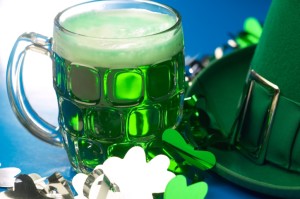 Over 33 million Americans claim some form of Irish heritage, which is seven times more people than the entire population of Ireland itself. For many, St. Patrick’s Day is about leprechauns, parades, beer and shamrocks, but the March 17 holiday actually holds a fair amount of religious significance as well. St. Patrick’s Day is celebrated a variety of ways in different places of the world.
Over 33 million Americans claim some form of Irish heritage, which is seven times more people than the entire population of Ireland itself. For many, St. Patrick’s Day is about leprechauns, parades, beer and shamrocks, but the March 17 holiday actually holds a fair amount of religious significance as well. St. Patrick’s Day is celebrated a variety of ways in different places of the world.
St. Patrick
St. Patrick is the patron saint of Ireland and was a 5th century priest and, later, a bishop. He is believed to have lived from approximately 390 to 461 A.D. Ironically, St. Patrick was not Irish, but born in Britain to an aristocratic Christian family. He was kidnapped by pirates around the age of 16 and transported to Ireland. Prior to being taken from his home, St. Patrick was not thought to be a believer in the Lord. His relationship with God changed during his captivity while he worked as a shepherd.
After six years of slavery, a voice in St. Patrick’s head reportedly told him it was time to go home. He was able to escape from his master, get on a boat and make his way back to Britain where he joined the priesthood. Later on, St. Patrick was given the difficult task of converting the largely Druid and pagan population of Ireland to Christianity, and was highly successful in his efforts. For several centuries after his death he was largely forgotten. However, over time, St. Patrick evolved into a mythological figure and by approximately the 9th or 10th century A.D. people began commemorating the day he died, March 17, as a feast day and minor religious holiday.
Traditions
There are many traditions associated with St. Patrick’s Day.
- For many years, the Irish Prime Minister has traveled on March 17 to the United States to meet with the President. It is customary for him or her to give the President a bowl of shamrocks as a symbol of the strong relationship between Ireland and the United States.
- Corned beef and cabbage is the traditional American St. Patrick’s Day meal. Irish immigrants in New York bought corned beef from the kosher butchers. In Ireland, it is customary to serve lamb or bacon on St. Patrick’s Day.
- Many people wear green on March 17. Green is the color of Ireland and the country is called the “Emerald Isle.” People who don’t wear green may get pinched.
Worldwide Celebrations
- Parades
Many cities including New York, Boston, Chicago, Philadelphia, New Orleans and Savannah host St. Patrick’s Day parades. The world’s largest takes place in New York City; two million people watch the parade and there are approximately 150,000 to 250,000 participants. Before the Chicago St. Patrick’s Day parade, the Chicago River that runs through the city is dyed green.
- Dublin, Ireland
Dublin is the home of one of the most spectacular St. Patrick’s Day celebrations. The city hosts a four day festival around the holiday that includes the Irish Beer and Whiskey Festival, boat races, musical performances, pub crawls and a large parade.
- Seeing Green
Green abounds on March 17. Several notable bodies of water are dyed green including the Chicago River, Indianapolis canal and Hillsborough River in Tampa. Boats, jet skis and kayaks are often used to churn the water so the dye diffuses. The water in the fountain on the south lawn of the White House has been dyed green every St. Patrick’s Day since President Obama was elected. Famous landmarks around the globe like the Sydney Opera House are bathed in green lights to commemorate the holiday. Many bars and pubs also serve green beer.
St. Patrick’s Day has now largely become a time to have fun. It is interesting to ponder what the priest for whom the holiday was named would think about how it is now celebrated.

